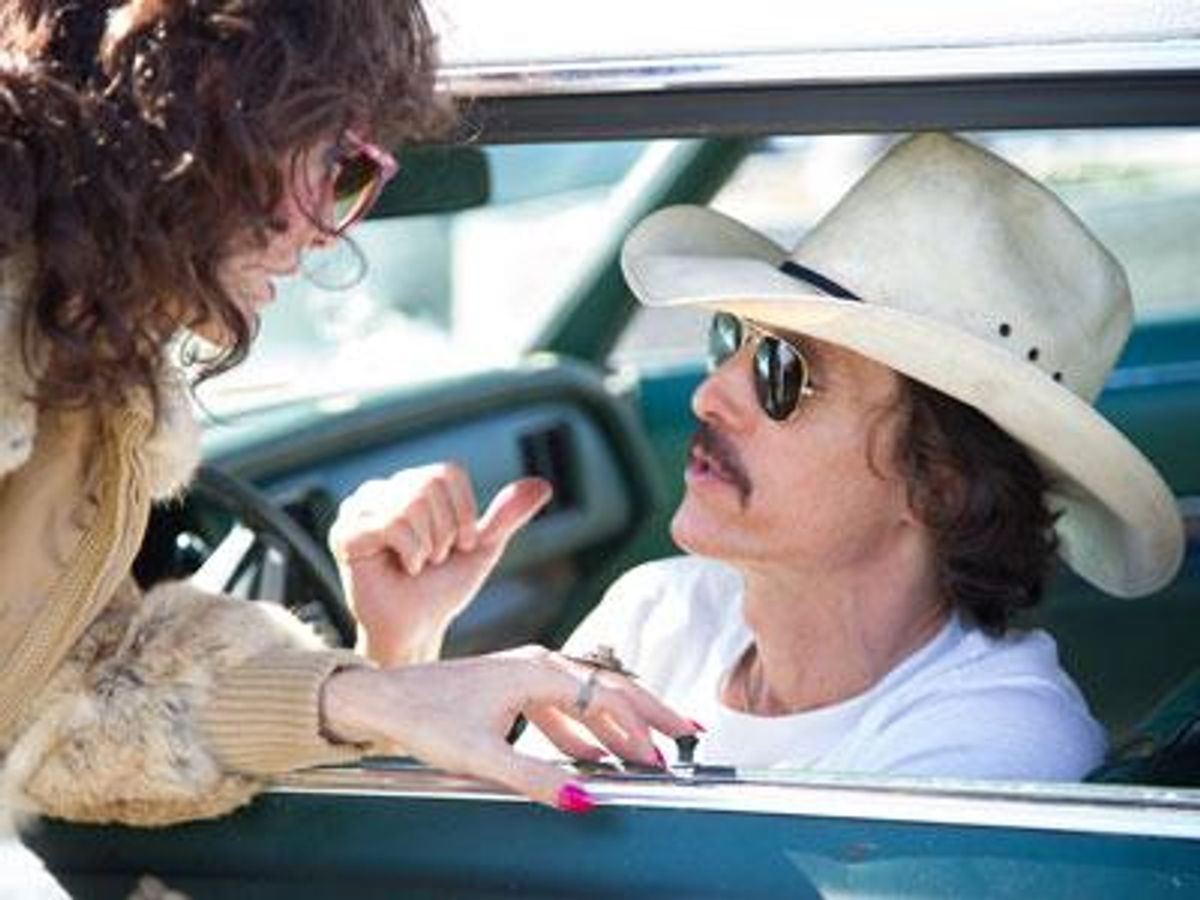In the first minutes of Dallas Buyers Club, the astounding new film about the darkest years of the AIDS crisis, rodeo cowboy Ron Woodroof (a gaunt and barely recognizable Matthew McConaughey) is punched in the face. He has it coming. The self-serving crook has a lot of enemies.
The blood spills from his mouth and glows a bright crimson, an almost clownish contrast to his drained, ghostly pallor, which itself is evidence of a raging HIV infection he has yet to discover. Another gash on his forehead is a shocking distillation of red, and unlike most movies in which injuries disappear by the next scene, the wound remains. And remains. For many scenes thereafter, the blood on Woodroof’s forehead is in full view, a disconcerting reminder of what lies beneath, until you wish he would just put on a bandage already.
But Dallas Buyers Club isn’t interested in making the truth very pretty. A river of infected blood runs through it. So too does practically every other bodily fluid, along with bruises that won’t heal and purple skin lesions and flakes of dry, reddened skin. And that’s kind of beautiful. Because that’s what AIDS looked like in 1985, and it’s been ages since we have fully remembered it. (This movie doesn’t concern itself with the modern day notion of “living with HIV,” since having the virus in those days typically meant an AIDS diagnosis and fast and efficient death.)
I have never seen AIDS shown this way in a film. And of all the movie portrayals of the disease, from Parting Glances to I Love You Phillip Morris, nothing else has captured the ugly physicality of AIDS like Dallas Buyers Club. Even the tearful hospital-bed goodbyes in Longtime Companion seem overly romanticized by comparison.
The based-on-a-true-story film concerns Woodroof, a hard-living cowboy and drug addict who must face certain death and the cruelty of his redneck buddies when he tests HIV-positive. Woodroof also lives the sheltered life of a Southern homophobe, so watching him negotiate the AIDS community terrain of queers, transgender women, and drag queens is fascinating viewing and provides some of the surprisingly plentiful humor in the film.
But Woodroof hasn’t successfully dodged the consequences of his petty crimes for nothing. He quickly cheats the system to acquire the poisonous medication AZT, and after an eye-opening trip to Mexico, he figures out how to profit from the sale of unapproved drugs to the throngs of support group members back home. Along the way, he allows himself a guarded friendship with a drug-addicted transgender woman, Rayon, who becomes his business partner (Jared Leto in an effective and quietly humble performance) and eventually accepts, to some degree, the gratitude and generosity of the many gay and trans people around him.
Nearly everyone in the story, patients and physicians alike, is a wretched outcast, damaged by drug addiction or homophobia or loneliness or their own destructive behaviors. No one is healed, no one fully conquers his or her demons, and no one gets out unscathed. The fact that the filmmakers make you root for every one of them is a testament to terrific storytelling and a vexing main character you grow to love and admire.
 These characters also live a world away from the more sophisticated New York City activists who populate the Oscar-nominated documentary from last year, How to Survive a Plague. In fact, the AIDS battles being waged elsewhere barely register in this story about Southern vice and ingenuity. When Woodroof and his rodeo buddies first learn of the death of Rock Hudson, they dismiss him as a cocksucker, except for one of the guys who doesn’t even know who the actor is. His buddies scoff. “Haven’t you ever seen North by Northwest?” one asks.
These characters also live a world away from the more sophisticated New York City activists who populate the Oscar-nominated documentary from last year, How to Survive a Plague. In fact, the AIDS battles being waged elsewhere barely register in this story about Southern vice and ingenuity. When Woodroof and his rodeo buddies first learn of the death of Rock Hudson, they dismiss him as a cocksucker, except for one of the guys who doesn’t even know who the actor is. His buddies scoff. “Haven’t you ever seen North by Northwest?” one asks.
Woodroof’s entrepreneurial efforts ultimately create the Dallas Buyers Club, a real business that provided unapproved medications to very desperate people with AIDS. As someone who once used a buyers’ club to purchase Compound Q and other pharmacological footnotes in HIV/AIDS history, I can attest that everything about the cheap plywood setup in the film to the anxious expressions on the customers felt tragically familiar.
The real villain in the story, other than the virus itself, would have to be the early, toxic drug AZT and its manufacturer. Although the film uses a fictional pharmaceutical name, historians note that AZT was produced by Burroughs Wellcome (eventually absorbed into GlaxoSmithKline), which downplayed side effects in a complicated rush by the Food and Drug Administration to have a drug, any drug, ready to treat the growing pandemic.
Matthew McConaughey is a revelation. His physical transformation alone would be Oscar bait were it not for his ability to gain our affections for such a self-serving swindler. Calling the performance free of vanity is an understatement. His harrowing depiction of living with AIDS makes the award-winning Philadelphia look about as realistic as Dark Victory. It reminds me of when we settled for scraps in Hollywood’s depiction of AIDS, when any major actor “brave enough” to play a gay man won an Oscar.
There is a moment late in the story during which Woodroof checks himself in the mirror before an evening out. Suddenly he finds himself staring, and in the dim bathroom light he sees the undamaged face of the man he might have been. He allows the slightest expression of pride, for the things he has accomplished, for those he has helped. And then, as those of us who lived through the 1980s know so well, the face returns to a look of both hope and despair, of the beautiful sadness that always brought too many questions about the fate that was barreling towards us.
It is that face in Dallas Buyers Club, the one free of blood and injury, that is the most haunting of all.
Activist and author Mark S. King is the journalist behind the blog My Fabulous Disease (MarkSKing.com).
Check out this Dallas Buys Club featurette:
More clips from the film:

 These characters also live a world away from the more sophisticated New York City activists who populate the Oscar-nominated documentary from last year, How to Survive a Plague. In fact, the AIDS battles being waged elsewhere barely register in this story about Southern vice and ingenuity. When Woodroof and his rodeo buddies first learn of the death of Rock Hudson, they dismiss him as a cocksucker, except for one of the guys who doesn’t even know who the actor is. His buddies scoff. “Haven’t you ever seen North by Northwest?” one asks.
These characters also live a world away from the more sophisticated New York City activists who populate the Oscar-nominated documentary from last year, How to Survive a Plague. In fact, the AIDS battles being waged elsewhere barely register in this story about Southern vice and ingenuity. When Woodroof and his rodeo buddies first learn of the death of Rock Hudson, they dismiss him as a cocksucker, except for one of the guys who doesn’t even know who the actor is. His buddies scoff. “Haven’t you ever seen North by Northwest?” one asks.















































































